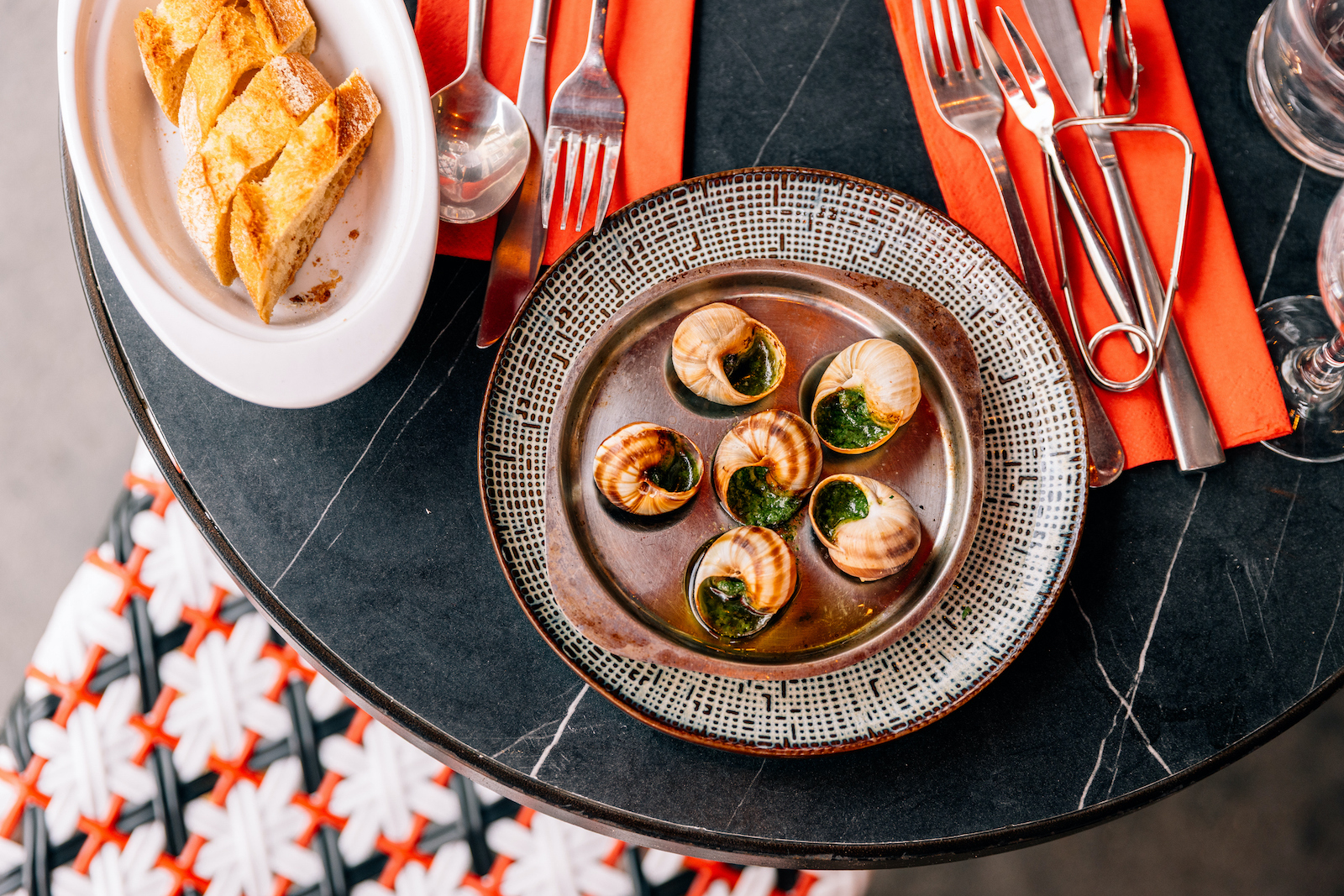French food finds its cool again

The martinis are cold, the oysters endless and every table sounds like a dinner party. Lately, going out for martinis, fries, and oysters has become the night-time version of matcha and froyo — a ritual, a little luxury. But when did our “savory treats” become so… French?
From West Village bistros to London brasseries, French cuisine — once dismissed as too heavy or too fussy — is suddenly what’s on everyone’s lips. After years of small plates and coastal Mediterranean, we’re saying oui to butter, béarnaise and bistro culture.
French is back, and this time, it’s cool.
According to Yelp data, searches for “Parisian restaurants” are up 125% in the past three months compared to last, with “steak frites” up 27% and even “French grocery stores” up 20%. French butter, that darling of TikTok bakers, is having its own viral moment — up 52% in searches.
“French food really is the cuisine of the moment,” says London chef and “French Classics” author Matthew Ryle. “The last couple years, all the restaurants opening seem to be French.”
It’s a shift that’s been building for months. In New York, classic spots like Le Veau d’Or — once the kind of hushed dining room your grandparents dressed up for — are being revived by Gen-Z tastemakers like A24 (in the form of Cherry Lane Theater’s new restaurant Wild Cherry). Libertine, Le Coucou, and Château Royale pack in diners who want the mood of Paris with the volume of a party. “People want to brush up against one another a bit more now,” said Café Kestral owner Dennis Spina to Eater. “I want it to feel festive.”
Craving comfort
So why the sudden appetite for French? The answer might be less about extravagance than ease.
Studies show that in times of stress, our bodies crave comfort — calorie-dense, nostalgic meals that promise both physical and psychological relief.
“It’s a very nostalgic food, a lot of people have nice memories tied to French food,” says Ryle, “It’s reliable and wholesome. If you go to a French restaurant, you know you’re going to leave full and have a good feeling.”
French cuisine absolutely fits the bill for comfort. After a long day, I find myself wishing I could curl up with French onion soup or tuck into a perfectly pink steak frites.
Now, after years of economic anxiety and bad news cycles, that comfort has become cool. A sort of status symbol among diners who want to prove they can not only pronounce bouillabaisse, but also know what’ s in it.
French food offers an indulgence that’s classic rather than chaotic — a small, buttery rebellion against burnout culture. It’s what some might call the edible version of quiet luxury: rich, yes, but never flashy.
“People aren’t necessarily going out to eat as much,” Ryle adds, “but if they do, they want to make sure they’re going somewhere they know they’re in for a good meal.”
Want more great food writing and recipes? Sign up for Salon’s free food newsletter, The Bite.
Bringing back bistro culture
Bistro culture is also having a social resurgence. Long, chatty meals over wine and pâté fit perfectly into a post-pandemic craving for connection, especially among Gen-Z. The new French spots aren’t stuffy temples of gastronomy where you’re scared to tap the fork too hard on your plate — they’re loud, martini-soaked rooms full of French 75s and friends arguing over the last fry.
“It’s casual,” says food writer and journalist Michael Ruhlman, “but again, to my mind, there’s no better cuisine than French cuisine. It tastes good, it’s so satisfying to eat. It’s the best kind of food to share and have a glass of wine amongst your friends and family.”
He calls it “a small renaissance” — one that’s about more than technique or trend. “It’s an appreciation of classic dishes that have been around for centuries,” he says. “They’re tradition.”
Across cities like New York and London, that tradition has evolved into a modern kind of “rustic luxe”: homey duck confit and steak au poivre served under soft lighting and mismatched furniture. The result feels less like fine dining and more like eating at a very chic friend’s apartment — one who happens to know how to make a perfect béarnaise.
“It’s just a chicken stew”
French cooking hasn’t always been this approachable. Many have tried — most notably Julia Child in the 60s and 70s — to convince home-chefs that (as Chef Gusteau says) anyone can cook, but Ryle thinks his method of meeting young people where they’re at (chronically online) is how Gen-Z can adopt French cuisine in their own kitchens. “I think, wrongly so, it has a stereotype for being hard to do,” Ryle says. “Chefs have purposefully made it feel unachievable. When you strip it back, it’s all from peasant cookery — people were cooking it on farms, around fires.”
Since its opening in 2021, Ryle’s restaurant Maison François has been lauded as one of the best French brasseries outside of France, both for its food and design. This year, Maison François made the list of top 100 restaurants in the UK for the National Restaurant Awards, and it was awarded the platinum star and Epicurean Excellence award from the International Culinary Union.
Following the success of the restaurant, he started posting more recipes and kitchen tips online. His Instagram has over two million followers and his TikTok has more than 405,000.
His new book, “French Classics,” and TikTok tutorials aim to “re-educate” people on the roots of those dishes. “If I tell my mom to make coq au vin, she’ll say, ‘Oh no, I can’t do that,’” he laughs. “But it’s just chicken stew. It’s really just making people aware of the roots.”
French cooking, in other words, has finally shaken off its starched-white-tablecloth reputation. You can learn to confit duck legs in your Air Fryer or make a hollandaise before work. (Ruhlman notes that the key is just to start simple — “make a hollandaise or confit duck legs and work your way up.”)
Even Julia Child’s shadow looms differently now. The OG home chef made French cuisine feel possible for Americans; Ryle’s generation is taking it one step further, making it feel lighthearted and casual. “People just need to cook more French food at home,” he says. “Everyone knows these flavors and these dishes but it’s just got a fancy French name, so trying to compare it to something that everyone is already aware of is how we make it accessible.”
But tonight? Pass the butter
Ruhlman has seen this all before. “It was the cuisine of America in the ‘60s,” he says, “and it was considered very high-end and chic. Then it became too stuffy and sort of fell out of favor.”
By the 1980s, “bad cooks ruined French cuisine,” he says, “until it started coming back in the ’90s.” Chefs like Thomas Keller, Charlie Trotter, Jean-Georges Vongerichten, and Eric Ripert (to name a few) are responsible for reviving the prestige and reputation of French flavors and technique in America in the ‘90s.
Now, with a new generation of chefs reclaiming its simplicity — and social media rewarding elegant minimalism — the pendulum has swung back again. It’s fitting that French food’s comeback isn’t about trend chasing but timelessness. As Ruhlman puts it, “Food is in constant evolution,” and right now, the pendulum is swinging towards mirepoix, hollandaise, and cassoulet.
For now, it’s all about steak frites and martinis. In a moment where everything feels uncertain, French food offers something grounded — food that knows exactly what it is.
As Ryle puts it, “In French food, the future is the past.” The ferris wheel will turn again, of course. But tonight? Pass the butter.
Read more
about this topic

